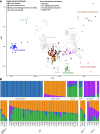The genomic portrait of the Picene culture provides new insights into the Italic Iron Age and the legacy of the Roman Empire in Central Italy
- PMID: 39567978
- PMCID: PMC11580440
- DOI: 10.1186/s13059-024-03430-4
The genomic portrait of the Picene culture provides new insights into the Italic Iron Age and the legacy of the Roman Empire in Central Italy
Abstract
Background: The Italic Iron Age is characterized by the presence of various ethnic groups partially examined from a genomic perspective. To explore the evolution of Iron Age Italic populations and the genetic impact of Romanization, we focus on the Picenes, one of the most fascinating pre-Roman civilizations, who flourished on the Middle Adriatic side of Central Italy between the 9th and the 3rd century BCE, until the Roman colonization.
Results: More than 50 samples are reported, spanning more than 1000 years of history from the Iron Age to Late Antiquity. Despite cultural diversity, our analysis reveals no major differences between the Picenes and other coeval populations, suggesting a shared genetic history of the Central Italian Iron Age ethnic groups. Nevertheless, a slight genetic differentiation between populations along the Adriatic and Tyrrhenian coasts can be observed, possibly due to different population dynamics in the two sides of Italy and/or genetic contacts across the Adriatic Sea. Additionally, we identify several individuals with ancestries deviating from their general population. Lastly, in our Late Antiquity site, we observe a drastic change in the genetic landscape of the Middle Adriatic region, indicating a relevant influx from the Near East, possibly as a consequence of Romanization.
Conclusions: Our findings, consistently with archeological hypotheses, suggest genetic interactions across the Adriatic Sea during the Bronze/Iron Age and a high level of individual mobility typical of cosmopolitan societies. Finally, we highlight the role of the Roman Empire in shaping genetic and phenotypic changes that greatly impact the Italian peninsula.
Keywords: Adriatic cultures; Ancient DNA; Ancient Italy; Archaeogenomics; Iron Age; Late Antiquity; Novilara necropolis; Picenes; Proto-history; Roman Empire.
© 2024. The Author(s).
Conflict of interest statement
Declarations. Ethics approval and consent to participate: Not applicable. Consent for publication: Not applicable. Competing interests: The authors declare that they have no competing interests.
Figures




Similar articles
-
Ancient genomes from a rural site in Imperial Rome (1st-3rd cent. CE): a genetic junction in the Roman Empire.Ann Hum Biol. 2021 May;48(3):234-246. doi: 10.1080/03014460.2021.1944313. Ann Hum Biol. 2021. PMID: 34459338
-
Ancient genomes reveal structural shifts after the arrival of Steppe-related ancestry in the Italian Peninsula.Curr Biol. 2021 Jun 21;31(12):2576-2591.e12. doi: 10.1016/j.cub.2021.04.022. Epub 2021 May 10. Curr Biol. 2021. PMID: 33974848
-
Iron Age Italic population genetics: the Piceni from Novilara (8th-7th century BC).Ann Hum Biol. 2018 Feb;45(1):34-43. doi: 10.1080/03014460.2017.1414876. Ann Hum Biol. 2018. PMID: 29216758
-
Through 40,000 years of human presence in Southern Europe: the Italian case study.Hum Genet. 2021 Oct;140(10):1417-1431. doi: 10.1007/s00439-021-02328-6. Epub 2021 Aug 19. Hum Genet. 2021. PMID: 34410492 Free PMC article. Review.
-
Where Asia meets Europe - recent insights from ancient human genomics.Ann Hum Biol. 2021 May;48(3):191-202. doi: 10.1080/03014460.2021.1949039. Ann Hum Biol. 2021. PMID: 34459345 Review.
Cited by
-
Medieval genomes from eastern Iberia illuminate the role of Morisco mass deportations in dismantling a long-standing genetic bridge with North Africa.Genome Biol. 2025 Apr 28;26(1):108. doi: 10.1186/s13059-025-03570-1. Genome Biol. 2025. PMID: 40296056 Free PMC article.
-
A New Perspective on the Arrival of the Eastern Mediterranean Genetic Influx in Central Italy Before the Onset of the Roman Empire.Genome Biol Evol. 2025 Jul 30;17(8):evaf149. doi: 10.1093/gbe/evaf149. Genome Biol Evol. 2025. PMID: 40720742 Free PMC article.
References
-
- Pallottino M. A History of Earliest Italy. University of Michigan Press; 1991.
-
- Buti GG, Devoto G. Preistoria e storia delle regioni d’Italia: Una introduzione. Sansoni; 1974.
-
- Bietti Sestieri AM. L’Italia nell’età del bronzo e del ferro: dalle palafitte a Romolo (2200–700 a.C.). Carocci; 2010.
-
- Naso A. I Piceni: storia e archeologia delle Marche in epoca preromana. Longanesi; 2000.
Publication types
MeSH terms
Substances
LinkOut - more resources
Full Text Sources
Miscellaneous

